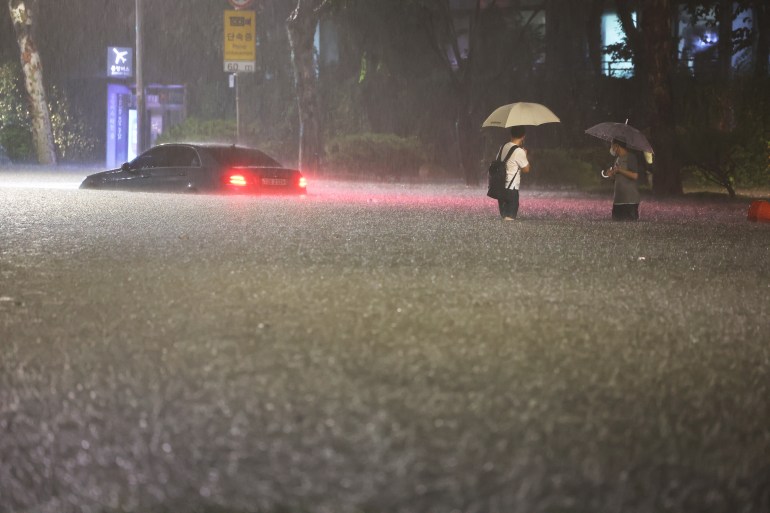At least 7 dead, as South Korea’s Seoul deluged by record rain
Heaviest rainfall in 80 years submerges homes and metro system, triggers landslides and knocks out power around the capital.

At least seven people have died and six were missing in and around Seoul, the South Korean capital, after torrential rain knocked out power, triggered landslides and flooded homes and the city’s metro system.
The southern part of Seoul was deluged in more than 100mm (3.9 inches) of rain an hour late on Monday, with the rain in some parts of the city reaching 141.5mm (5.7 inches) an hour, according to Korea Meteorological Administration (KMA).

The Yonhap news agency said the downpour was the heaviest in 80 years.
Keep reading
list of 4 itemsSouth Korea’s prices soar to near quarter-century high
Workers at ‘South Korean Amazon’ protest ‘boiling pot’ conditions
North Korea reports no new ‘fever’ cases for first time since May
At least five people died in Seoul, while two were killed in nearby Geyonggi province by early Tuesday, the Central Disaster and Safety Countermeasures Headquarters said.
Three of the victims were people living in a banjiha – cramped basement flats of the kind depicted in Bong Joon-ho’s Oscar-winning Parasite – in Seoul’s Gwanak district.
The Yonhap news agency said the three included a teenager and that the family had reported that they were trapped in their basement home on Monday evening. They were later found dead.
More sad news emerging. They had already reported their house was flooding the day before. By the time rescue workers arrived, the family was dead. One of the victims had down's syndrome.
Always the most vulnerable communities affected.https://t.co/Wdlrh6w6zh
— Raphael Rashid (@koryodynasty) August 9, 2022
Disaster officials said a fourth person also died in Seoul after being trapped in a flooded building, while another was believed to have been electrocuted as he tried to clear a fallen tree from the roadside.
In the city of Gwangju in the Geyonggi province, one person was found under the wreckage of a collapsed bus station while another died after being buried in a landslide.
At least nine people were injured, while six were missing.

In Seoul’s glitzy Gangnam district, some buildings and shops were flooded and without power on Tuesday, while cars, buses and metro stations were submerged, leaving people stranded.
“I was near Gangnam station last night when the rainfall intensified, with thunder and lightning striking every 30 seconds,” said Lee Dongha, a 27-year-old office worker in Seoul.
“All of a sudden, buses, subway stations and streets were submerged, and that’s when I quickly decided to book an accommodation as I didn’t want to be left stranded, with nowhere to go.”
President Yoon Suk-yeol ordered government officials to evacuate residents from high-risk areas and encouraged businesses to allow employees flexible commuting hours on Tuesday morning.
“Nothing is more precious than life and safety. The government will thoroughly manage the heavy rain situation,” he wrote on his Facebook account.
The Interior Ministry raised its flood watch level to “serious” on Tuesday, while the Korea Forest Service issued landslide advisories in 46 cities and counties across the country, including in nine districts in Seoul, according to Yonhap.
The KMA meanwhile maintained a heavy rain warning for the Seoul metropolitan area, which is home to 26 million people, for Tuesday and said the precipitation may reach 50 to 100 mm an hour (2 to 4 inches) in some areas.
It said it expects heavy rainfall for the central part of the country to continue until at least Wednesday.
While South Korea often experiences heavy rain in summer, “such sharp increase in precipitation and frequent torrential rains cannot be explained without the big trend of climate change,” a KMA official, who spoke in condition of anonymity, told the Reuters news agency.
“This phenomenon is seen occurring more often due to climate change that has resulted in a prolonged summer.”